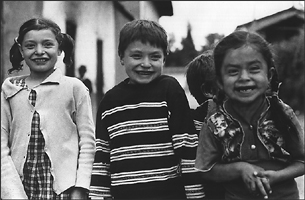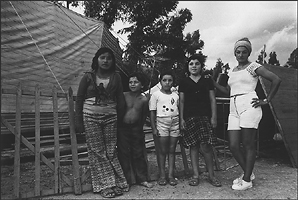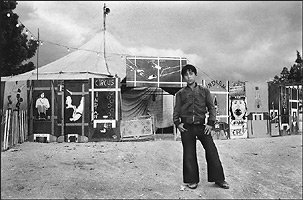




Home Ecuador
Several days after the beginning of Carnival, I was on our second story porch doing some wash when I noticed that one of the items had disappeared from the drying line. I looked all around, but could find it nowhere. Thinking it might have blown into someone’s yard, I went downstairs to make some inquiries. I was standing on the sidewalk talking to Sra. Piña, the landlord’s wife, when I was hit by two waves of water from above. The landlady gasped and her hand flew to her mouth. I looked up, and the girl who works for the landlord was looking out a window. She claimed it was an accident, that the wind had blown the bucket over. I think that she was grabbing fate by the collar and taking advantage of an easy mark. I eventually found the garment in question. It hadn’t blown down, but up, onto the roof.
Sometimes we would stand by the railing in our third floor kitchen with a pot of water, waiting for unsuspecting pedestrians and bike riders. We weren’t particularly good marksmen. The sheet of water would fly silently downward and land with a splat, prompting our intended victim to run down the street.
The following Sunday it was raining, so throwing water was somewhat redundant. It was generally agreed that older people should be considered non-combatants, but they sometimes became reluctant victims at the mercy of bands of balloon-toting warriors. This was a welcome time to take out hostilities and confer attentions on fellow citizens in a socially acceptable manner, and most people took advantage of it. I used to watch the owner of a corner store nearby who had hidden a bucket of water within easy reach in his doorway. He perched at the store entrance like a spider on his web, and would race out after fleeing targets, bucket in hand and water flying.
When market day came around again, there was one table where some different items were for sale, special Carnival paraphernalia: flour, corn starch, balloons, squirt guns, and carioca. Carioca was packed into an aerosol can, and could be ejected at a target from a considerable distance at the touch of a button. As we stood there admiring the display, a man walked over to the table and picked up a can. “Carioca”, he said, “Linda es!”, and he sprayed a white foamy blob of it on the front of Peggy’s shirt in way of demonstration. “Feo” she said. Just then a water balloon zoomed in, but only got her a little wet. We were walking away and I turned and noticed another coming in our direction. I said, “Look out!”, but to little effect as it burst on Peggy’s back. After this initial flurry, the squirt guns that followed us were less dramatic, and less painful than a balloon in the kidney.
As Carnival was building to a peak, I made a trip to Cuenca to change some of our traveler’s checks into sucres, and buy some “necessities” that couldn’t be obtained in Gualaceo, such as butter and olives. I avoided doorways from which water-throwers were likely to rush, and kept my eyes on balconies overlooking the street, where many people were gathered in anticipation. The main park in town was the staging area for gangs of men using the fountain as their water source. They stood by the street and tried to throw balloons into the windows of cars where the drivers were ignorant enough to leave them open. Pick-up trucks with a load of people in the back cruised the streets as voluntary, and well-received, moving targets, except at intersections where they became the proverbial sitting ducks.
On the final Saturday of Carnival, there was a dance in town. We put on our snappiest clothes, and Peggy was wearing her new shoes. We walked down to the dance with Roman and Noralma, our neighbors downstairs. Everyone was dressed up for the affair. The men were wearing suits and the women their formal dresses, and with their hair trained for the occasion. The dance was being held in the courtyard of the colegio in town. Standing in the street outside were many well-dressed young men checking out the arriving revelers. We could hear the music coming through the walls. I stood in line to buy our tickets, jostling with other men who habitually make liberal use of the elbows in such a situation. The price was 100 sucres for the men, and the women gratis.
We stepped inside, and then outside again, for the courtyard was open to the stars. The asphalt-paved area was well lit with strings of lights, and a row of chairs lined the perimeter where many of the women were sitting. Some of them looked a bit sullen, perhaps in anticipation of what was to come. A salsa band with a horn section and lots of percussion was churning our some fine dance music at one end of the yard. At the other end were several tables from which refreshments were being served. The men were mostly standing around the tables at this early point in the evening, and there were very few people dancing. But the evening was to be far from dull.
As more people arrived, more chairs were brought out for the women who sat watching, and a few more couples began to dance. One of the main refreshments was that locally brewed firewater derived from sugar cane, Zhumir. It was served straight or mixed with a hot juice and sugar combination, which was somewhat more palatable. As the night burned on, people became looser and the dance floor began to fill. We were dancing to one number when we saw an acquaintance who looked like his face was being occupied by a pink cloud. Peggy went over to ask, in jest, what had happened, and received a foamy shot of carioca in the head in response. We retreated to somewhere we felt was a little safer, which happened to be near the liquor table. The cans of carioca were coming out of pockets now, and could be purchased in a room off the dance floor. A lot of guys had the pink stuff on their head and clothes. The area where we were standing was no longer safe. There was probably no place in that courtyard that was safe. People were shooting carioca everywhere. The face and head were the main targets, and the concoction burned the skin a little. It was settling down on the coiffed heads and finely-clothed shoulders of the women sitting in the chairs like a fine mountain snowstorm. Our intended retreat brought us into the midst of some older gentlemen who started buying us shots of Zhumir. We bought them drinks in return, and were soon thoroughly drunk and drenched in carioca. It burned our eyes and smelled like bad perfume. As soon as it could be wiped off, the newly cleared area would attract another shot. The dance floor was packed now, and everyone had a can of carioca in the hand. We eventually had to leave while we could still stagger home.
The next day, Sunday, we were somewhat incapacitated with hangovers, but still managed to struggle down to the market to do some shopping. There were generally fewer people in attendance due to last night’s affair, and a respect for flying water balloons. Someone scored a direct hit on our egg basket, cracking nine but only breaking one. There were a lot of people walking about with prematurely grey heads due to a baptism in a mixture of water and flour, or corn starch.
Early the next morning, we were awakened by a knocking on our door. It was Leonardo’s two younger brothers, Eugenio and Augustine. They had come to accompany us to their parents’ house at Cafshan for a Carnival celebration. Outside there was a series of sharp reports, holiday rockets being sent heaven-ward. We put some things in the pack and stuffed our sleeping bags, and carried the guitar up the hill, a brisk exercise before breakfast. When we arrived, Leonardo’s and Claudia’s families were seated around a pig in the yard. The pig was blackened and laying on its side. Our hosts were trimming the top layer of skin away, and enjoying the cáscaras for breakfast. They had some salt or salted water to dip them in, and móte (hominy) as the side dish. We partook of some trago, brewed personally by Leonardo from something like orange juice, pimiento, anise, and sugar, and aged fifteen days in bottles.
After the cáscaras, most of the day was spent butchering the pig, preparing food, and drinking shots of trago and muscatel. Sr. Cárdenas did most of the cutting on the pig. He turned it belly up and made an incision from the neck to the tail. The blood, which had gathered around the neck, was scooped out by hand and cup, and poured in a pot where it lay giving up its steamy warmth to the sky. The entrails were extracted next, then the heart with the nail which brought death still embedded in it, the kidneys and liver, and finally all the intestines which were heaped on a large wooden tray. The interior of the pig was rinsed with water, and then the entire carcass was hung by a rope from a beam at the side of the house. The rest of the skin was removed and saved for later, leaving the body gleaming snow-white in its coat of fat. This was sliced into strips latitudinally, and the carcass left to rest for a while.
Meanwhile, at a table in the shade of the house, a basket of heads of cabbage was being reduced to fine pieces with knives and machetes. This would be mixed with herbs and blood from the pig, and stuffed into the intestines which Leonardo had taken down to the creek to clean. The conversation revolved around the topic of fighting husbands and wives, and the causes. Comments were tossed out to the accompaniment of the chopping knives. There was also some guitar-playing and singing by Leonardo and Augustine.
Sr. Cárdenas soon returned to the pig, first stripping away all the fat, and then the meat, and placing everything in a large copper pot which he said was forty-five or fifty years old. Some of the meat was left in the pot to be cooked immediately, and the rest was cut into thinner strips and salted. The salted meat was later hung near the ceiling from beams in one of the buildings to be cured.
After the carcass had been stripped, it was time to eat some more. Our meal was made up of chicken broth soup with bits of potato and a hunk of chicken in it, freshly slaughtered that morning. The soup was followed by cooked black figs in a thick syrup. This sweet, sticky syrup was applied to the hair, face, and clothes of Claudia and Leonardo and several others as a signal of the next activity. Most of us of fewer years were given containers and urged to go down to the creek. Once there, we ran and slipped in the dirt and mud, and river rocks, and threw water at each other until everyone was thoroughly soaked. Several pans had soot-blackened bottoms, and this was utilized to produce thick black smudges on unlucky faces. We chased each other on the muddy paths and through the fields of corn to make sure no one harbored dry spots. Then we returned up the hill to the house to dry off and change clothes.
Those who had refrained from the water games had cut the fat into smaller pieces to be rendered in the copper pot. A spot was prepared outside the kitchen where a fire was built, and the pot perched on three big stones over it. The flames were fed with wood, bunches of eucalyptus, and penco cactus, and the wind dropped by to fan the fire until it was roaring. The contents of the pot were stirred with a huge wooden spoon, and after about an hour, the liquid fat (manteca) was dipped out. This was strained through a basket into an earthenware pot. The meat that had been left to cook along with the fat was served up on enamel plates atop móte, and immediately consumed by all. After the last of the fat was rendered, the remaining meat and browned pieces of fat was put on plates, and we ate this with móte accompanied by trago and chicha. Earlier, the intestines had been stuffed with the cabbage mixture, and now they were cooked in a broth in the copper pot. When done, they were hot and spicy. After dinner, we sat in the dark and played cards by the light of a kerosene lamp. Worn out by the day’s activities and feasting, we soon retired.
Before we left in the morning, we were served a breakfast of tinto con leche, bread, and a small buttery avocado with móte, of course. We took some more polaroids, and departed with a toast of chicha and trago. Back in town, some citizens were having a last fling with corn starch and water before the spirit of Carnival departed, taking with it that annualprivilege of aqueous assaults.